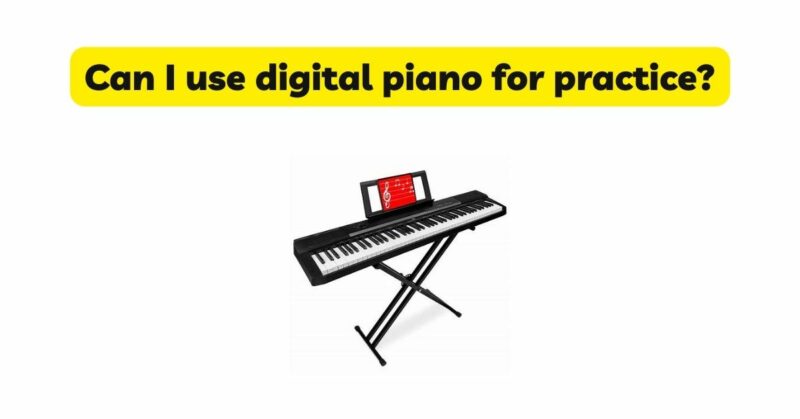Piano practice is an essential aspect of becoming a skilled pianist, and in today’s digital age, many aspiring musicians wonder if it’s suitable to use a digital piano for practice. In this article, we will explore the advantages, considerations, and potential benefits of using a digital piano for piano practice. By examining its unique features, sound quality, touch sensitivity, practice tools, and practicalities, we aim to provide insights that will empower individuals to make an informed decision about incorporating a digital piano into their practice routine.
- Sound Quality and Reproduction: One of the primary concerns when using a digital piano for practice is the sound quality and reproduction. High-quality digital pianos have made significant advancements in replicating the sound of an acoustic piano. Advanced sampling technology captures the nuances of an acoustic piano’s sound, offering multiple sampled piano tones that closely emulate the tonal characteristics of various acoustic pianos. While the sound may not be identical to that of a grand or upright piano, it can still be incredibly satisfying and conducive to effective practice sessions.
- Touch Sensitivity and Key Action: Another crucial aspect of piano practice is the touch sensitivity and key action. Digital pianos strive to replicate the touch sensitivity of an acoustic piano by employing weighted or graded hammer action keys. These key actions simulate the feel and response of playing on an acoustic piano, providing a more authentic playing experience. While digital pianos may not fully replicate the touch sensitivity of an acoustic piano, they come close enough to allow for proper technique development, finger control, and expression during practice sessions.
- Practice Tools and Learning Features: Digital pianos offer a range of practice tools and learning features that can greatly enhance piano practice sessions. Many models come equipped with built-in metronomes, recording capabilities, and playback functions. These features allow pianists to practice with a steady rhythm, evaluate their playing, and track their progress over time. Additionally, digital pianos often offer integrated lesson functions, interactive tutorials, and connectivity to educational apps or software. These practice tools and learning features provide valuable guidance and support, enabling individuals to practice effectively and efficiently.
- Versatility and Sound Options: Using a digital piano for practice provides the advantage of versatility and sound options. Digital pianos offer a wide range of instrument sounds beyond just piano tones. They often feature additional voices, including strings, organs, synthesizers, and more. This versatility allows pianists to explore various genres, experiment with different sounds, and even create unique compositions. The availability of different instrument tones can inspire creativity and provide opportunities for musical exploration during practice sessions.
- Silent Practice: One significant advantage of using a digital piano for practice is the ability to practice silently with headphones. This feature allows pianists to practice without disturbing others, making it particularly beneficial for those living in apartments, shared spaces, or late-night practice sessions. Silent practice enables individuals to focus on their playing, concentration, and musical expression without worrying about noise levels. It also offers a level of privacy that can be valuable during the early stages of learning or when working on challenging pieces.
- Portability and Convenience: Digital pianos offer the advantage of portability and convenience, making them suitable for practice sessions in various settings. Unlike acoustic pianos, which are large, heavy, and immobile, digital pianos are generally compact and lightweight. They can be easily moved, allowing pianists to practice in different rooms, spaces, or even take the instrument outside the home for rehearsals or performances. This portability provides flexibility and convenience, accommodating the needs of individuals with limited space or those who want to practice on the go.
- Cost and Maintenance: Digital pianos are often more affordable than acoustic pianos, making them an attractive option for many pianists. They require minimal maintenance compared to acoustic pianos, eliminating the need for regular tuning and potential repair costs. Digital pianos are generally more durable and less susceptible to wear and tear, ensuring long-term reliability and reducing ongoing maintenance expenses. This cost-effectiveness makes them a practical choice for pianists, particularly those on a budget or looking for an instrument that is low maintenance.
Conclusion: Using a digital piano for piano practice offers numerous advantages and benefits for aspiring pianists. Digital pianos provide high-quality sound reproduction, touch sensitivity, and a range of practice tools and learning features. They offer versatility, convenience, and the option for silent practice with headphones. Additionally, digital pianos are portable, cost-effective, and require minimal maintenance compared to acoustic pianos.
While digital pianos may not completely replicate the experience of playing on an acoustic piano, they offer significant advantages that can greatly enhance practice sessions. The decision to incorporate a digital piano into your practice routine depends on your personal circumstances, preferences, and goals. It’s important to consider factors such as sound quality, touch sensitivity, practice tools, convenience, and budget when making the decision. Ultimately, consistent practice, dedication, and a love for music are the keys to progress as a pianist. Embrace the digital piano as a valuable tool for practice, and enjoy the journey of musical growth and expression.


